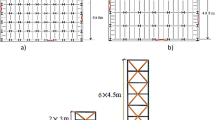Abstract
The calibration and validation of a low-cost external six-component wind tunnel balance (WTB), designed based on Stewart platform configuration, are reported using four different calibration designs. The balance can be easily customised to measure the aerodynamics loads acting on half-wing and drone models in a wind tunnel. Four calibration designs—central composite design (CCD), Box–Behnken design (BBD), BBD with two active filters and decoupling (BBD-2A), and the modern design of experiments (MDOE)—were thoroughly investigated using different computational and statistical techniques to find the right candidate through analysis of variance (ANOVA). A novel approach employed to find reduced model for each loading component in the four calibration designs is described. Systematic validation of the reduced models is performed by benchmarking them against the standard second-order models. These reduced models will play a vital role during actual calibration and measurements to lower the final uncertainty in the measured force and moment components and reduce the time and cost involved in calibrating a WTB.






Similar content being viewed by others
References
Barlow JB, Rae WH, Pope A (1999) Low-speed wind tunnel testing. Wiley, New York
Box GE, Behnken DW (1960) Some new three level designs for the study of quantitative variables. Technometrics 2(4):455–475
Box GE, Wilson KB (1951) On the experimental attainment of optimum conditions. J R Stat Soc Ser B 13(1):1–38
Callahan RJ (2016) Long-term quantitative study of wind-tunnel balance calibrations across multiple calibration systems, Master Dissertation, Old Dominion University
Doebelin EO, Manik DN (2007) Measurement systems: application and design
Dubois M (1981) Six-component strain-gage balances for large wind tunnels. Exp Mech 21(11):401–407
Ewald BF (2000) Multi-component force balances for conventional and cryogenic wind tunnels. Meas Sci Technol 11(6):R81
Fernandes JP (2018) Pinheiro Fernandes design of a wind tunnel force balance, Master Dissertation, Técnico Lisboa
Ferreira Manuel Aguiar (2015) Design of a six-component external wind tunnel Balance, Master Dissertation, Técnico Lisboa
González MA, Ezquerro JM, Lapuerta V, Laverón A, Rodríguez J (2011) Components of a wind tunnel balance: design and calibration. Wind Tunnels Exp Fluid Dyn Res 5:115–134
Kumar R (2020) Design and development of a low cost 6-component wind tunnel balance. MSc Tech Thesis, IIT Tirupati
Landman D, Toro KG, Commo SA, Lynn KC (2015) Prediction interval development for wind-tunnel balance check-loading. J Aircraft 52(3):884–889
Landman D, Yoder D (2014) Wind-tunnel balance calibration with temperature using design of experiments. J Aircraft 51(3):841–848
Lee HH (2018) Finite element simulations with ANSYS workbench 18. SDC publications
Monkewitz M, Müller J (2008) Measuring of long truck models in a wind tunnel with external balance, No. 2008-01-1202, SAE Technical Paper
Montgomery DC (1997) Design and analysis of experiments. Wiley, New York
Morris M, Post S (2010) Force balance design for educational wind tunnels. American Society for Engineering Education, American Society for Engineering Education, New York
Myers RH, Montgomery DC, Anderson-Cook CM (2002) Process and product optimization using designed experiments. In: Response surface methodology, pp 328–335
Noor AM, Mansor S (2013) Measuring aerodynamic characteristics using high performance low speed wind tunnel at Universiti Teknologi Malaysia. J Appl Mech Eng 3(132):1–7
Nouri NM, Mostafapour K (2016) Development and evaluation of calibration procedure for a force-moment balance using design of experiments. Latin Am J Solids Struct 13(1):119–135
Parker P, Morton M, Draper N, Line W (2001) A single-vector force calibration method featuring the modern design of experiments (invited). In: 39th Aerospace sciences meeting and exhibit
Preusser TIMM, Polansky L (1989) External 6-component wind tunnel balances for aerospace simulation facilities. In: International congress on instrumentation in aerospace simulation facilitie, IEEE
Raush G, Castilla R, Gamez-Montero PJ, Wojciechowski J, Codina E (2016) Flexible rod design for educational wind balance. Exp Tech 40:111–119
Reis MLCC, Castro RM, Mello OAF (2013) Calibration uncertainty estimation of a strain-gage external balance. Measurement 46(1):24–33
Rhew RD, Parker PA (2016) Wind tunnel balance calibration: are 1,000,000 data points enough?
Rhew RD (2012) Wind tunnel force balance calibration study-interim results
Samardžić M, Anastasijević Z, Marinkovski D, Ćurčiáć D, Isaković J (2014) External six-component strain Gauge balance for low speed wind tunnels. Sci Tech Rev 64(3):40–46
Simpson J, Landman D, Giroux R, Zeisset M, Hall B, Rhew R (2005) Calibrating large capacity aerodynamic force balances using response surface methods, US air force T&E days conferences
Smith DL (1972) An efficient algorithm using matrix methods to solve wind tunnel force-balance equations
Stolarski T, Nakasone Y, Yoshimoto S (2018) Engineering analysis with ANSYS software. Butterworth-Heinemann, Oxford
Tavakolpour-Saleh AR, Setoodeh AR, Gholamzadeh M (2016) A novel multi-component strain-gauge external balance for wind tunnel tests: simulation and experiment. Sens Actuators A Phys 247:172–186
Acknowledgements
The last author thanks the Indian Institute of Technology (IIT) Tirupati for funding this research through a New Faculty Initiation Grant (NFIG).
Author information
Authors and Affiliations
Corresponding author
Additional information
Publisher's Note
Springer Nature remains neutral with regard to jurisdictional claims in published maps and institutional affiliations.
A Appendix
A Appendix
Tables 3, 4, 5, 6, 7, 8, 9, 10, 11, 12, and 13.
Rights and permissions
About this article
Cite this article
Kumar, R., Srivatsa, B.N.R. & Subramanian, B. Calibration design evaluations through computational analysis and investigation of a six-component wind tunnel balance. ISSS J Micro Smart Syst 10, 7–31 (2021). https://doi.org/10.1007/s41683-021-00066-5
Received:
Revised:
Accepted:
Published:
Issue Date:
DOI: https://doi.org/10.1007/s41683-021-00066-5








